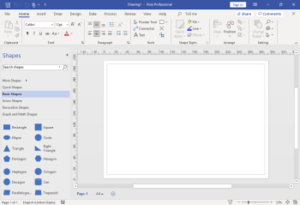Microsoft Visio

Microsoft Visio 2013 Professional on Windows 8
|
|
| Developer(s) | Microsoft |
|---|---|
| Stable release |
2016 (16.0.4266.1003) / September 22, 2015
|
| Operating system | Microsoft Windows |
| Type | Diagramming software |
| License | Trialware |
| Website | visio |
| VSD | Drawing |
|---|---|
| VSS | Stencil |
| VST | Template |
| VSW | Web drawing |
| VDX | XML drawing (Discontinued) |
| VSX | XML stencil (Discontinued) |
| VTX | XML template (Discontinued) |
| VSDX | OPC/XML drawing |
| VSDM | OPC/XML drawing, macro-enabled |
| VSSX | OPC/XML stencil |
| VSSM | OPC/XML stencil, macro-enabled |
| VSTX | OPC/XML template |
| VSTM | OPC/XML template, macro-enabled |
| VSL | Add-on |
Microsoft Visio (/ˈvɪz.i.oʊ/ VIZ-ee-oh) (formerly Microsoft Office Visio) is a diagramming and vector graphics application and is part of the Microsoft Office family. The product was first introduced in 1992, made by the Shapeware Corporation. It was acquired by Microsoft in 2000.
Microsoft made Visio 2013 for Windows available in two editions: Standard and Professional. The Standard and Professional editions share the same interface, but the Premium edition has additional templates for more advanced diagrams and layouts, as well as capabilities intended to make it easy for users to connect their diagrams to data sources and to display their data graphically. The Premium edition features three additional diagram types, as well as intelligent rules, validation, and subprocess (diagram breakdown). Visio Professional is also offered as an additional component of an Office365 subscription.
On 22 September 2015, Visio 2016 was released alongside Microsoft Office 2016. A few new features have been added such as one-step connectivity with Excel data, information rights management (IRM) protection for Visio files, modernized shapes for office layout, detailed shapes for site plans, updated shapes for floor plans, modern shapes for home plans, IEEE compliant shapes for electrical diagrams, new range of starter diagrams, and new themes for the Visio interface.
Database modeling in Visio revolves around a Database Model Diagram (DMD).
Visio 2010 and earlier versions read and write drawings in VSD or VDX file formats. All of the previous versions of Visio used VSD, the proprietary binary-file format. VDX is a well-documented XML Schema-based ("DatadiagramML") format.
...
Wikipedia
